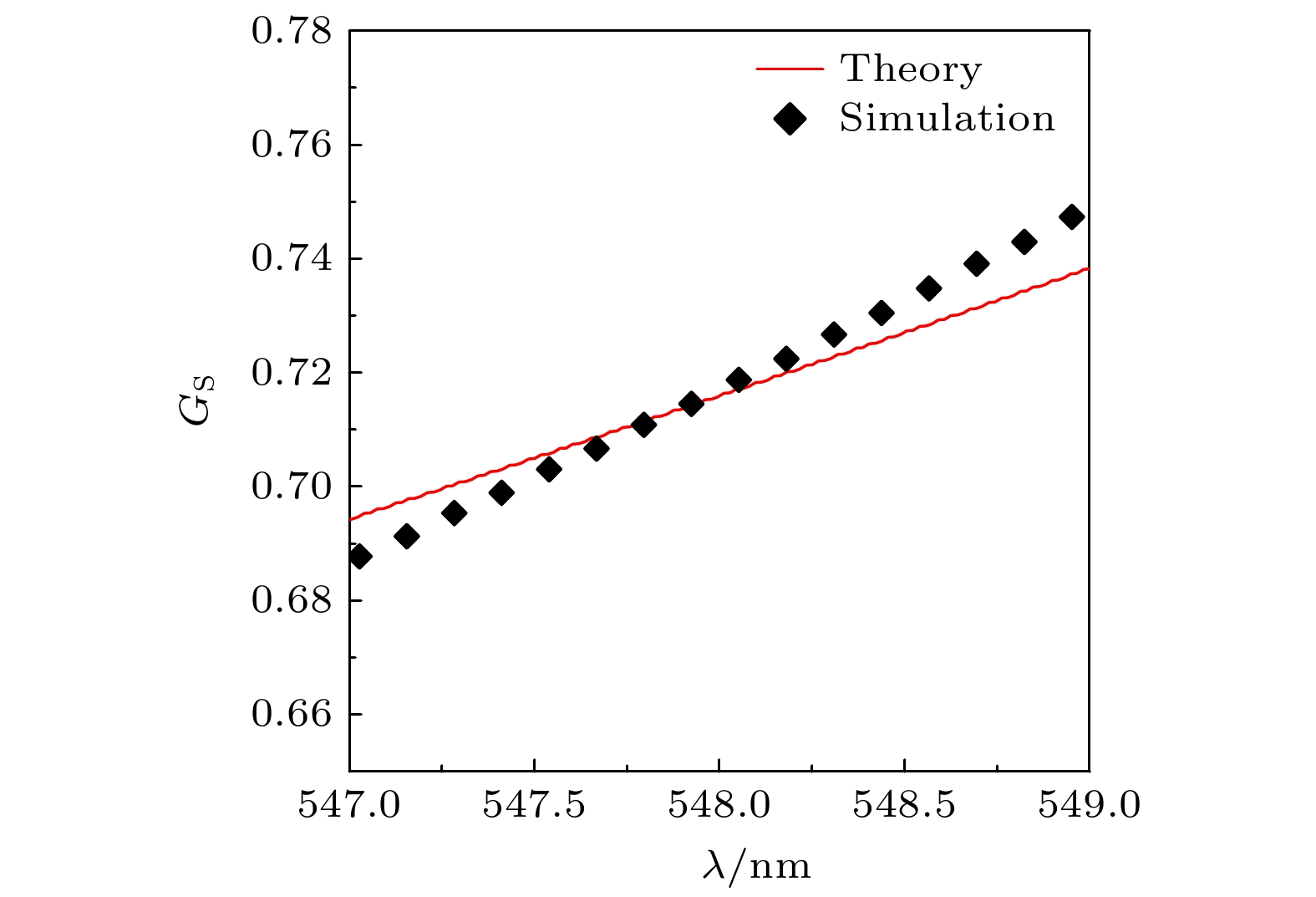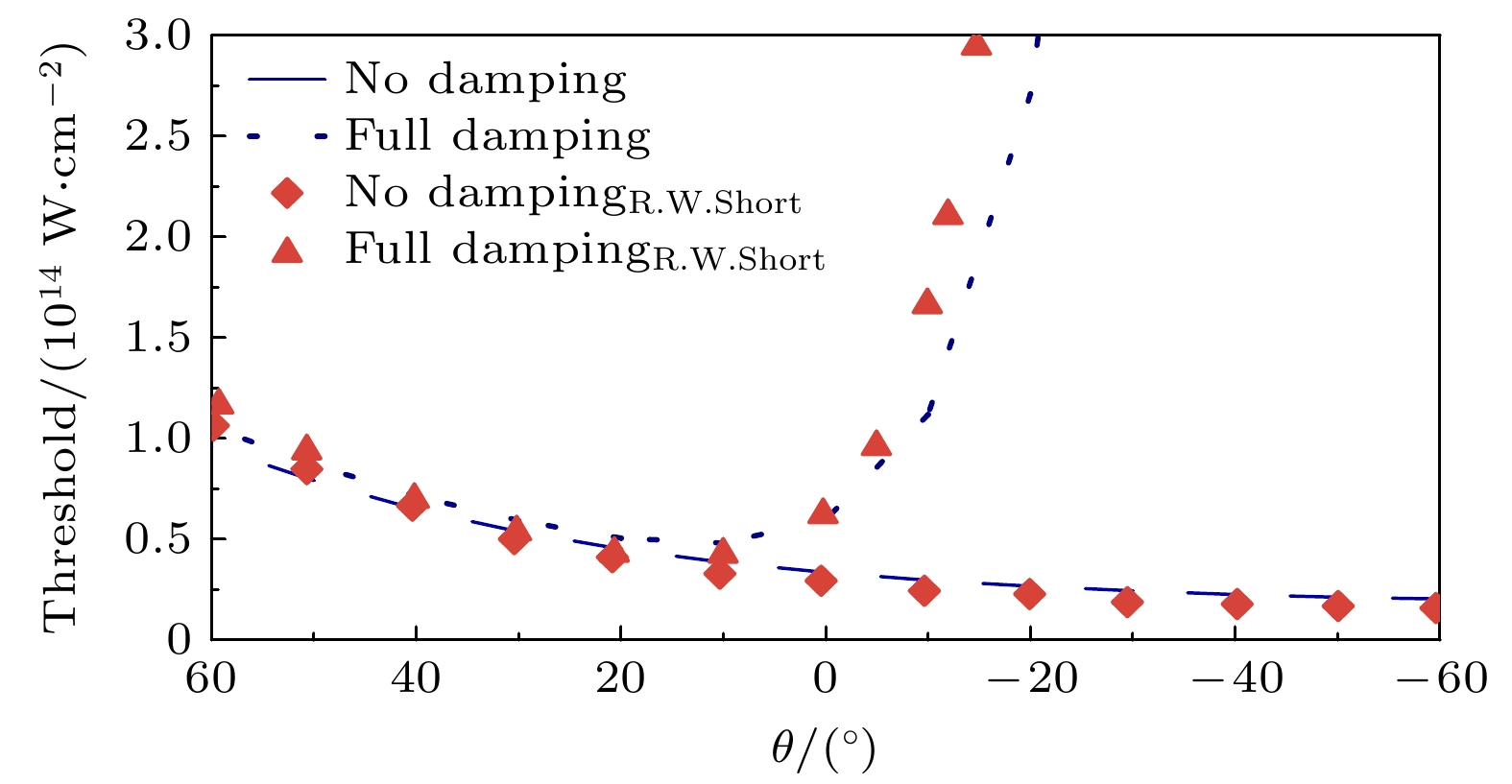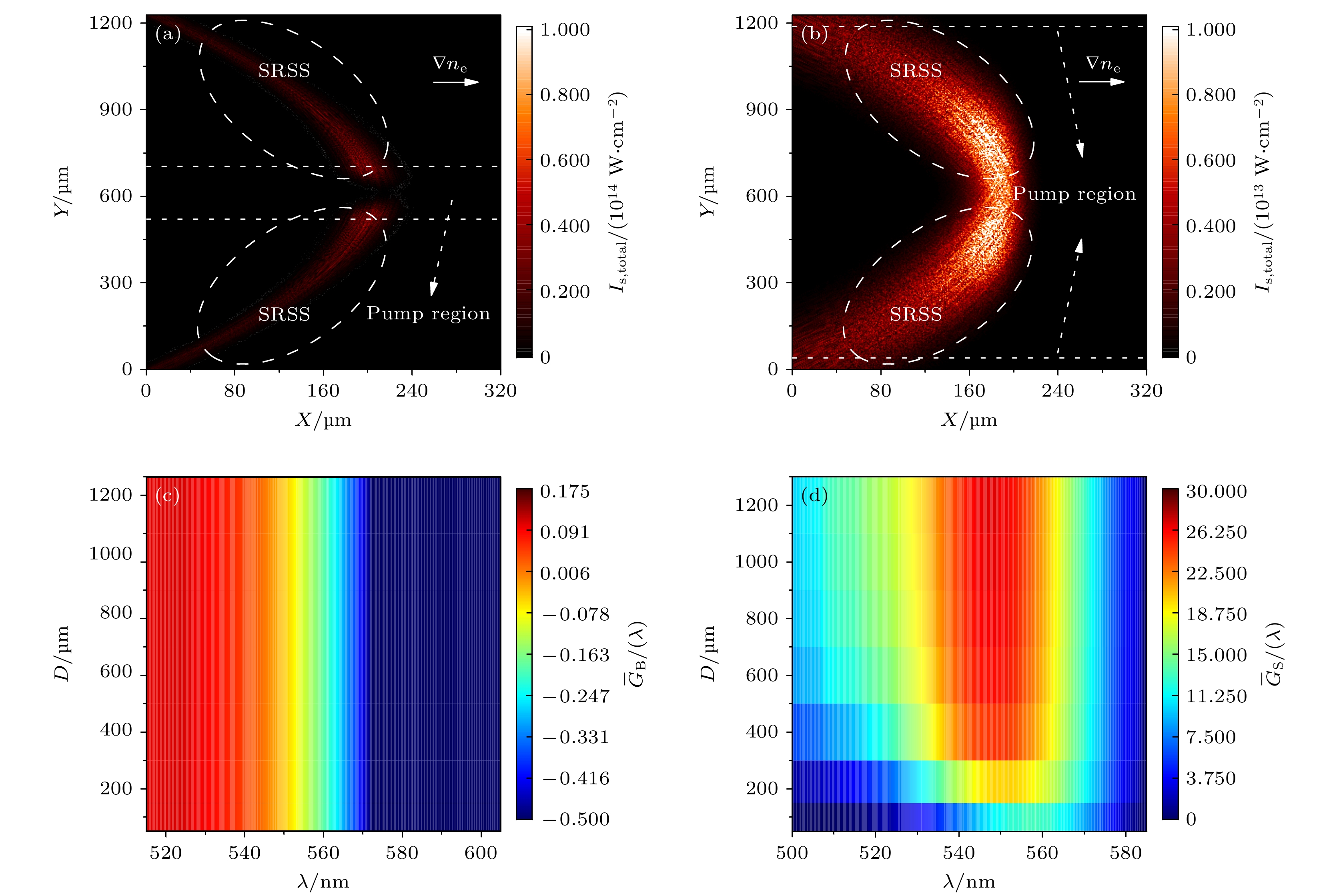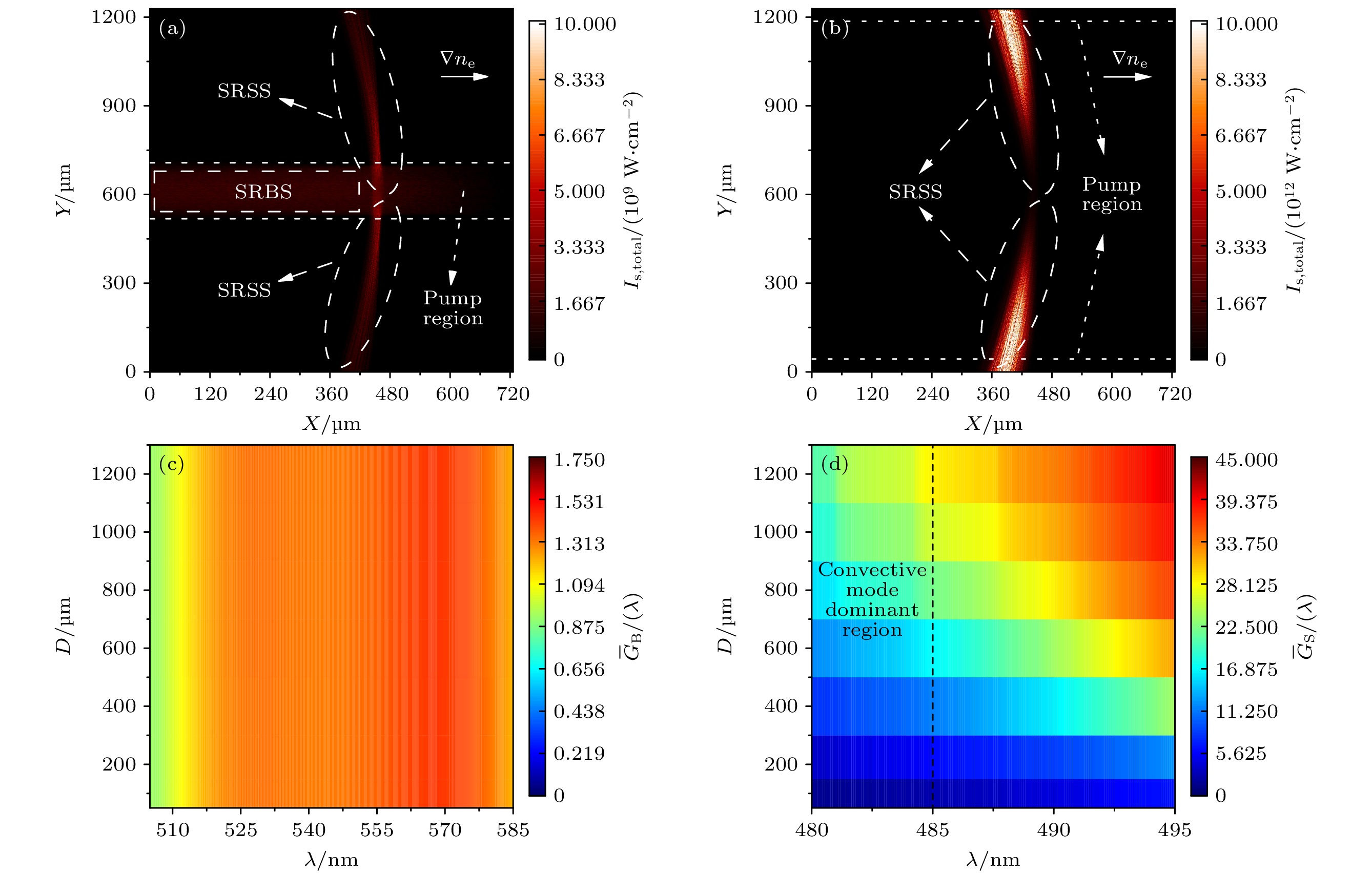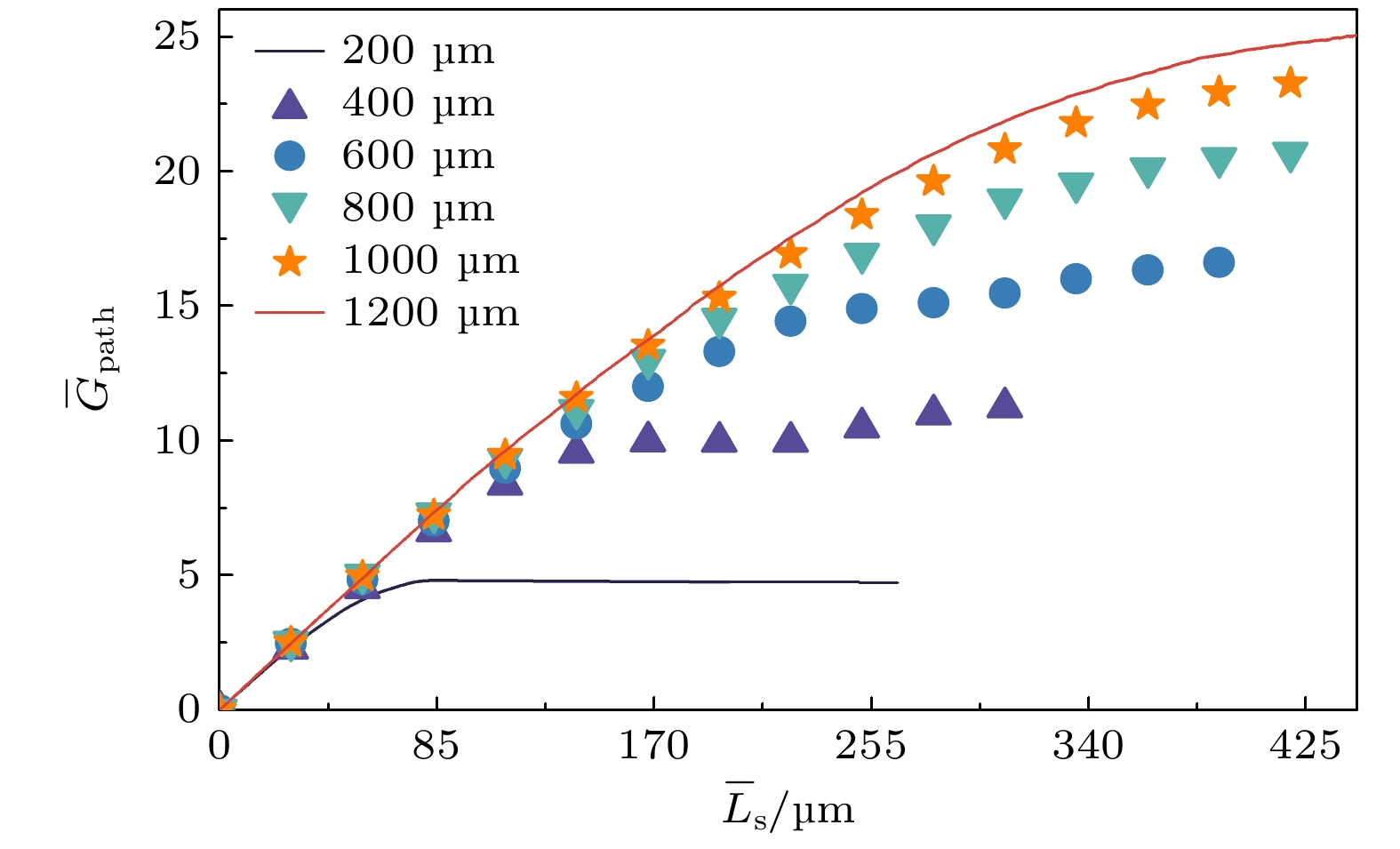-
The large-spatial-scale stimulated Raman scattering relevant to the SG-III prototype indirect drive parameters is investigated by using the code PHANTAM, which is based on ray tracing and convective amplification. The simulations show that strong stimulated Raman side scattering processes occur in both empty hohlraum and gasfilled hohlraum. The incident laser spot size is found to be the critical factor affecting stimulated Raman side scattering: under the constant laser intensity conditions, the convective gain of stimulated Raman side scattering increases with the laser spot size increasing in both types of hohlraums. In our simulations, the wavenumber mismatch leads to a saturation of the convection gain of the stimulated Raman side scattering in empty hohlraum, while in gas-filled hohlraum the convection gain of the stimulated Raman side scattering keeps increasing as the spot size increases. Under constant laser power conditions, the convective gain of stimulated Raman side scattering decreases while laser spot size increases, and the convective gain of stimulated Raman side scattering decreases faster in empty hohlraum in our simulations. The convective gain of Raman side scattering can be adjusted by laser spot size.
-
Keywords:
- laser plasma instability /
- stimulated Raman side scattering /
- convective mode /
- ray tracing
[1] Betti R, Hurricane O A 2016 Nat. Phys. 12 435
 Google Scholar
Google Scholar
[2] Craxton R S, Anderson K S, Boehly T R, et al. 2015 Phys. Plasmas 22 110501
 Google Scholar
Google Scholar
[3] Lindl J D, Amendt P, Berger R L, Glendinning S G, Glenzer S H, Haan S W, Kauffman R L, Landen O L, Suter L J 2004 Phys. Plasmas 11 339
 Google Scholar
Google Scholar
[4] Zylstra A B, Hurricane O A, Callahan D A, et al. 2022 Nature 601 542
 Google Scholar
Google Scholar
[5] Abu-Shawareb H, Acree R, Adams P, et al. 2022 Phys. Rev. Lett. 129 075001
 Google Scholar
Google Scholar
[6] Betti R 2022 Nat. Rev. Phys. 5 6
 Google Scholar
Google Scholar
[7] Tollefson J, Gibney E 2022 Nature 612 597
 Google Scholar
Google Scholar
[8] Hayes A C, Kyrala G, Gooden M, et al. 2023 Phys. Plasmas 30 072704
 Google Scholar
Google Scholar
[9] Kruer W L 1988 The Physics of Laser Plasma Interactions (New York: Addison-Wesley) pp73–85
[10] Strozzi D J, Bailey D S, Michel P, Divol L, Sepke S M, Kerbel G D, Thomas C A, Ralph J E, Moody J D, Schneider M B 2017 Phys. Rev. Lett. 118 025002
 Google Scholar
Google Scholar
[11] Montgomery D S 2016 Phys. Plasmas 23 055601
 Google Scholar
Google Scholar
[12] Rosenberg M J, Solodov A A, Seka W, et al. 2020 Phys. Plasmas 27 042705
 Google Scholar
Google Scholar
[13] Yan R, Li J, Ren C 2014 Phys. Plasmas 21 062705
 Google Scholar
Google Scholar
[14] Liu C S, Rosenbluth M N, White R B 1973 Phys. Rev. Lett. 31 697
 Google Scholar
Google Scholar
[15] Afeyan B B, Williams E A 1985 Phys. Fluids 28 3397
 Google Scholar
Google Scholar
[16] Figueroa H, Joshi C, Azechi H, Ebrahim N A, Estabrook K 1984 Phys. Fluids 27 1887
 Google Scholar
Google Scholar
[17] Drake R P, Turner R E, Lasinski B F, Estabrook K G, Campbell E M, Wang C L, Phillion D W, Williams E A, Kruer W L 1984 Phys. Rev. Lett. 53 1739
 Google Scholar
Google Scholar
[18] Drake R P, Turner R E, Lasinski B F, et al. 1988 Phys. Fluids 31 3130
 Google Scholar
Google Scholar
[19] Renard N, Labaune C, Baldis H A, Bauer B S, Quesnel B, Schifano E, Michard A, Seka W, Estabrook K G 1996 Phys. Rev. Lett. 77 3807
 Google Scholar
Google Scholar
[20] Michel P, Rosenberg M J, Seka W, et al. 2019 Phys. Rev. E 99 033203
 Google Scholar
Google Scholar
[21] Rosenberg M J, Solodov A A, Myatt J F, et al. 2023 Phys. Plasmas 30 042710
 Google Scholar
Google Scholar
[22] Depierreux S, Neuville C, Baccou C, et al. 2016 Phys. Rev. Lett. 117 235002
 Google Scholar
Google Scholar
[23] Hironaka S, Sivajeyan J, Wang J, Rosenberg M J, Solodov A, Filkins T, Xiao C, Wang Q, Seka W, Myatt J F 2023 Phys. Plasmas 30 022708
 Google Scholar
Google Scholar
[24] Short R W 2020 Phys. Plasmas 27 042703
 Google Scholar
Google Scholar
[25] Michel P, Divol L, Dewald E L, Milovich J L, Hohenberger M, Jones O S, Hopkins L B, Berger R L, Kruer W L, Moody J D 2015 Phys. Rev. Lett. 115 055003
 Google Scholar
Google Scholar
[26] Dewald E L, Hartemann F, Michel P, et al. 2016 Phys. Rev. Lett. 116 075003
 Google Scholar
Google Scholar
[27] Moody J D, Datte P, Krauter K, et al. 2010 Rev. Sci. Instrum 81 10D921
 Google Scholar
Google Scholar
[28] Hall G N, Jones O S, Strozzi D J, et al. 2017 Phys. Plasmas 24 052706
 Google Scholar
Google Scholar
[29] Hao L, Zhao Y, Yang D, et al. 2014 Phys. Plasmas 21 072705
 Google Scholar
Google Scholar
[30] Strozzi D J, Williams E A, Hinkel D E, Froula D H, London R A, Callahan D A 2008 Phys. Plasmas 15 102703
 Google Scholar
Google Scholar
[31] 龚韬 2015 博士学位论文 (合肥: 中国科学技术大学)
Gong T 2015 Ph. D. Dissertation (Hefei: University of Science and Technology of China
[32] Xiao C Z, Wang Q, Myatt J F 2023 Phys. Rev. E 107 025203
 Google Scholar
Google Scholar
[33] Hao L, Yang D, Li X, et al. 2019 AIP Adv. 9 095201
 Google Scholar
Google Scholar
[34] Colaïtis A, Igumenshchev I, Mathiaud J, Goncharov V 2021 J. Comput. Phys. 443 110537
 Google Scholar
Google Scholar
[35] Debayle A, Ruyer C, Morice O, Masson-Laborde P E, Loiseau P, Benisti D 2019 Phys. Plasmas 26 092705
 Google Scholar
Google Scholar
[36] Colaïtis A, Follett R K, Palastro J P, Igumenschev I, Goncharov V 2019 Phys. Plasmas 26 072706
 Google Scholar
Google Scholar
[37] Follett R K, Edgell D H, Froula D H, Goncharov V N, Igumenshchev I V, Shaw J G, Myatt J F 2017 Phys. Plasmas 24 103128
 Google Scholar
Google Scholar
[38] Kaiser T B 2000 Phys. Rev. E 61 895
 Google Scholar
Google Scholar
[39] Forslund D W, Kindel J M, Lindman E L 1975 Physics of Fluids 18 1002
 Google Scholar
Google Scholar
[40] Drake J F, Kaw P K, Lee Y C, Schmid G, Liu C S, Rosenbluth M N 1974 Phys. Fluids 17 778
 Google Scholar
Google Scholar
[41] Rosenbluth M N 1972 Phys. Rev. Lett. 29 565
 Google Scholar
Google Scholar
[42] Huo W Y, Ren G, Lan K, et al. 2010 Physics of Plasmas 17 123114
 Google Scholar
Google Scholar
[43] Huo W Y, Lan K, Li Y, et al. 2012 Phys. Rev. Lett. 109 145004
 Google Scholar
Google Scholar
[44] Huo W Y, Yang D, Lan K, et al. 2014 Physics of Plasmas 21 022704
 Google Scholar
Google Scholar
[45] Xiao C Z, Zhuo H B, Yin Y, Liu Z J, Zheng C Y, Zhao Y, He X T 2018 Plasma Phys. Control. Fusion 60 025020
 Google Scholar
Google Scholar
[46] Landau L D, Ter-Haar D 1965 Collected Papers of L.D. Landau (Oxford: Pergamon) pp445–460
-
图 1 光线追踪模块校验结果 (a)入射光轨迹在等离子体中传播的轨迹图, 背景为等离子体的电子密度分布, 白线和黑线分别代表DX = DY = 0.05 μm时, 入射光轨迹的模拟结果和理论结果; (b)模拟结果和理论结果在一个周期内的相对误差随DY的变化. DX和DY分别代表X方向和Y方向的网格精度, 定义为DX = Xmax/NX, DY = Ymax/NY, Xmax, Ymax分别为X方向和Y方向的长度, NX和NY则分别代表X方向和Y方向的网格数
Figure 1. Benchmark results of the ray tracing module: (a) Pump ray trajectory of simulation (white line) and theory (black line) superimposed on the electron density with DX = DY = 0.05 μm; (b) relative error between the theory and simulation results over a period vs. DY. The grid size DX and DY are defined as DX = Xmax/NX and DY = Ymax/NY, the Xmax and Ymax are the lengths of the X and Y directions, the NX and NY are the number of grids in the X and Y directions, respectively.
图 2 (a)均匀等离子体中SRBS的增益因子$ G_{{\mathrm{B}}} $随电子温度的变化, 此时固定电子密度为$ n_{{\mathrm{e}}0} =0.05 n_{{\mathrm{c}}} $; (b) SRBS的增益因子$ G_{{\mathrm{B}}} $随电子密度的变化, 此时固定电子温度为$ T_{{\mathrm{e}}} $ = 3.0 keV
Figure 2. (a) SRBS gain ($ G_{{\mathrm{B}}} $) vs. electron temperature for the uniform plasma for the const density $ n_{{\mathrm{e}}0} =0.05 n_{{\mathrm{c}}}$; (b) $ G_{{\mathrm{B}}} $ vs. electron density for the const temperature $ T_{{\mathrm{e}}} $ = 3.0 keV.
图 4 SRS散射光设置示意图 (a)散射光初始传播方向示意图, 红色箭头代表入射光的传播方向, 蓝色、绿色箭头代表SRSS和SRBS的初始传播方向, 红色、蓝色、绿色的圆圈则代表入射光、SRSS、SRBS散的偏振方向; (b)散射光传播轨迹示意图, 背景为等离子体的电子密度分布, 白色实线代表散射光的传播轨迹, 紫色的箭头代表散射光传播的方向, 黑色虚线代表入射光经过的区域
Figure 4. Schematic of SRS configuration: (a) Schematic of the initial propagation direction of SRS, the red arrow represents the propagation direction of the incident light, the blue and green arrows represent the initial propagation direction of SRSS and SRBS, and the red, blue and green circles represent the polarisation direction of the incident light, SRSS and SRBS; (b) schematic of the SRS ray trajectory, superimposed on a plot of the electron density, the white line and violet arrow are the trajectory and direction of SRS ray, the black dashed line represents the region incident light passes.
图 6 真空腔模拟结果 (a) SRS散射光光强的空间分布(焦斑直径取200 μm, 与Case I对应), 白色长虚线区域为SRSS光强较大的区域, 白色短点虚线区域为入射光所在区域; (b) SRS散射光光强的空间分布(焦斑直径取1200 μm, 与Case II对应); (c) SRBS频谱(D = 200 μm时与Case I对应, D = 1200 μm时与Case II对应); (d) SRSS频谱
Figure 6. Simulation results of empty hohlraum: (a) Profile of SRS light intensity (spot diameter is taken as 200 μm, corresponds to Case I), the white dashed line is the region where the SRSS light intensity is stronger, and the white dotted line is the region where the incident light is located; (b) profile of SRS light intensity (spot diameter is taken as 1200 μm, corresponds to Case II); (c) spectrum of SRBS (D = 200 μm corresponds to Case I, and D = 1200 μm corresponds to Case II); (d) spectrum of SRSS.
图 7 $0.1 n_{{\mathrm{c}}} $处产生的SRS的相关统计量随平均路程的变化, 实线代表SRSS, 虚线代表SRBS (a)散射光对流增益与耦合系数随传播路程的变化; (b)入射光光强, 以及等离子体的密度和温度随传播路程的变化. 除(19)式$ \bar{G}_{{\mathrm{path}}} $外, 其余各个物理量的统计方式与$ \bar{\varGamma}_{\alpha} $保持一致, 详见(20)式
Figure 7. Statistical physical quantities vs. average distance of SRS generated at $0.1 n_{{\mathrm{c}}} $, the solid line and the dashed line are the physical quantities of SRSS and SRBS, respectively. (a) $ \bar{G}_{{\mathrm{path}}} $ and coupling coefficient vs. average distance; (b) incident light intensity, electron density, and electron temperature of plasma vs. average distance. Statistical methods of each physical quantity are consistent with $ \bar{\varGamma}_{\alpha} $ shown in Eq. (20), except for $ \bar{G}_{{\mathrm{path}}} $ defined in Eq. (19).
图 8 充气腔模拟结果 (a) SRS散射光光强的空间分布(焦斑直径取200 μm, 与Case III对应), 白色长虚线区域为SRSS光强较大的区域, 白色短点虚线区域为入射光所在区域; (b) SRS散射光光强的空间分布(焦斑直径取1200 μm, 与Case IV对应); (c) SRBS频谱(D = 200 μm时与Case III对应, D = 1200 μm时与Case IV对应); (d) SRSS频谱, 黑色虚线左侧为对流模区间, 而虚线右侧通常被认为是绝对模区间
Figure 8. Simulation results of gas-filled hohlraum: (a) Profile of SRS light intensity (spot diameter is taken as 200 μm, corresponds to Case III), the white dashed line is the region where the SRSS or SRBS light intensity is stronger, and the white dotted line is the region where the incident light is located; (b) profile of SRS light intensity (spot diameter is taken as 1200 μm); (c) spectrum of SRBS (D = 200 μm corresponds to Case III, and D = 1200 μm corresponds to Case IV); (d) spectrum of SRSS, the left side of the black dotted line is convective mode dominant region, and the right side is usually treated as absolute mode region.
图 10 光强保持不变的条件下SRSS增益随焦斑直径的变化 (a)真空腔; (b)充气腔. 红色实点、蓝色实点分别代表不同入射光光强的模拟结果, 红色虚线、蓝色虚线则代表对数据点的拟合
Figure 10. SRSS gain vs. spot diameter for the constant light intensity: (a) Empty hohlraum; (b) gas-filled hohlraum. The red dots and blue dots are the simulation results of different incident light intensity, the red dashed line and the blue dashed line represent the fitting results of data points, respectively.
图 11 功率保持不变的条件下SRSS增益随焦斑直径的变化 (a)真空腔; (b)充气腔. 红色实点、蓝色实点分别代表不同入射光功率时的模拟结果, 红色虚线、蓝色虚线则代表对数据点的拟合
Figure 11. SRSS gain vs. spot diameter for the constant power: (a) Empty hohlraum; (b) gas-filled hohlraum. The red dots and blue dots are the simulation results of different incident light power, the red dashed line and the blue dashed line represent the fitting results of data points, respectively.
表 1 部分模拟算例参数设置
Table 1. Parameters setting of several simulation cases.
Case $ I_{0, {\mathrm{max}}} $/(1015 W·cm–2) D/μm 腔类型 I 1.5 200 真空腔 II 1.5 1200 真空腔 III 1.5 200 充气腔 IV 1.5 1200 充气腔 -
[1] Betti R, Hurricane O A 2016 Nat. Phys. 12 435
 Google Scholar
Google Scholar
[2] Craxton R S, Anderson K S, Boehly T R, et al. 2015 Phys. Plasmas 22 110501
 Google Scholar
Google Scholar
[3] Lindl J D, Amendt P, Berger R L, Glendinning S G, Glenzer S H, Haan S W, Kauffman R L, Landen O L, Suter L J 2004 Phys. Plasmas 11 339
 Google Scholar
Google Scholar
[4] Zylstra A B, Hurricane O A, Callahan D A, et al. 2022 Nature 601 542
 Google Scholar
Google Scholar
[5] Abu-Shawareb H, Acree R, Adams P, et al. 2022 Phys. Rev. Lett. 129 075001
 Google Scholar
Google Scholar
[6] Betti R 2022 Nat. Rev. Phys. 5 6
 Google Scholar
Google Scholar
[7] Tollefson J, Gibney E 2022 Nature 612 597
 Google Scholar
Google Scholar
[8] Hayes A C, Kyrala G, Gooden M, et al. 2023 Phys. Plasmas 30 072704
 Google Scholar
Google Scholar
[9] Kruer W L 1988 The Physics of Laser Plasma Interactions (New York: Addison-Wesley) pp73–85
[10] Strozzi D J, Bailey D S, Michel P, Divol L, Sepke S M, Kerbel G D, Thomas C A, Ralph J E, Moody J D, Schneider M B 2017 Phys. Rev. Lett. 118 025002
 Google Scholar
Google Scholar
[11] Montgomery D S 2016 Phys. Plasmas 23 055601
 Google Scholar
Google Scholar
[12] Rosenberg M J, Solodov A A, Seka W, et al. 2020 Phys. Plasmas 27 042705
 Google Scholar
Google Scholar
[13] Yan R, Li J, Ren C 2014 Phys. Plasmas 21 062705
 Google Scholar
Google Scholar
[14] Liu C S, Rosenbluth M N, White R B 1973 Phys. Rev. Lett. 31 697
 Google Scholar
Google Scholar
[15] Afeyan B B, Williams E A 1985 Phys. Fluids 28 3397
 Google Scholar
Google Scholar
[16] Figueroa H, Joshi C, Azechi H, Ebrahim N A, Estabrook K 1984 Phys. Fluids 27 1887
 Google Scholar
Google Scholar
[17] Drake R P, Turner R E, Lasinski B F, Estabrook K G, Campbell E M, Wang C L, Phillion D W, Williams E A, Kruer W L 1984 Phys. Rev. Lett. 53 1739
 Google Scholar
Google Scholar
[18] Drake R P, Turner R E, Lasinski B F, et al. 1988 Phys. Fluids 31 3130
 Google Scholar
Google Scholar
[19] Renard N, Labaune C, Baldis H A, Bauer B S, Quesnel B, Schifano E, Michard A, Seka W, Estabrook K G 1996 Phys. Rev. Lett. 77 3807
 Google Scholar
Google Scholar
[20] Michel P, Rosenberg M J, Seka W, et al. 2019 Phys. Rev. E 99 033203
 Google Scholar
Google Scholar
[21] Rosenberg M J, Solodov A A, Myatt J F, et al. 2023 Phys. Plasmas 30 042710
 Google Scholar
Google Scholar
[22] Depierreux S, Neuville C, Baccou C, et al. 2016 Phys. Rev. Lett. 117 235002
 Google Scholar
Google Scholar
[23] Hironaka S, Sivajeyan J, Wang J, Rosenberg M J, Solodov A, Filkins T, Xiao C, Wang Q, Seka W, Myatt J F 2023 Phys. Plasmas 30 022708
 Google Scholar
Google Scholar
[24] Short R W 2020 Phys. Plasmas 27 042703
 Google Scholar
Google Scholar
[25] Michel P, Divol L, Dewald E L, Milovich J L, Hohenberger M, Jones O S, Hopkins L B, Berger R L, Kruer W L, Moody J D 2015 Phys. Rev. Lett. 115 055003
 Google Scholar
Google Scholar
[26] Dewald E L, Hartemann F, Michel P, et al. 2016 Phys. Rev. Lett. 116 075003
 Google Scholar
Google Scholar
[27] Moody J D, Datte P, Krauter K, et al. 2010 Rev. Sci. Instrum 81 10D921
 Google Scholar
Google Scholar
[28] Hall G N, Jones O S, Strozzi D J, et al. 2017 Phys. Plasmas 24 052706
 Google Scholar
Google Scholar
[29] Hao L, Zhao Y, Yang D, et al. 2014 Phys. Plasmas 21 072705
 Google Scholar
Google Scholar
[30] Strozzi D J, Williams E A, Hinkel D E, Froula D H, London R A, Callahan D A 2008 Phys. Plasmas 15 102703
 Google Scholar
Google Scholar
[31] 龚韬 2015 博士学位论文 (合肥: 中国科学技术大学)
Gong T 2015 Ph. D. Dissertation (Hefei: University of Science and Technology of China
[32] Xiao C Z, Wang Q, Myatt J F 2023 Phys. Rev. E 107 025203
 Google Scholar
Google Scholar
[33] Hao L, Yang D, Li X, et al. 2019 AIP Adv. 9 095201
 Google Scholar
Google Scholar
[34] Colaïtis A, Igumenshchev I, Mathiaud J, Goncharov V 2021 J. Comput. Phys. 443 110537
 Google Scholar
Google Scholar
[35] Debayle A, Ruyer C, Morice O, Masson-Laborde P E, Loiseau P, Benisti D 2019 Phys. Plasmas 26 092705
 Google Scholar
Google Scholar
[36] Colaïtis A, Follett R K, Palastro J P, Igumenschev I, Goncharov V 2019 Phys. Plasmas 26 072706
 Google Scholar
Google Scholar
[37] Follett R K, Edgell D H, Froula D H, Goncharov V N, Igumenshchev I V, Shaw J G, Myatt J F 2017 Phys. Plasmas 24 103128
 Google Scholar
Google Scholar
[38] Kaiser T B 2000 Phys. Rev. E 61 895
 Google Scholar
Google Scholar
[39] Forslund D W, Kindel J M, Lindman E L 1975 Physics of Fluids 18 1002
 Google Scholar
Google Scholar
[40] Drake J F, Kaw P K, Lee Y C, Schmid G, Liu C S, Rosenbluth M N 1974 Phys. Fluids 17 778
 Google Scholar
Google Scholar
[41] Rosenbluth M N 1972 Phys. Rev. Lett. 29 565
 Google Scholar
Google Scholar
[42] Huo W Y, Ren G, Lan K, et al. 2010 Physics of Plasmas 17 123114
 Google Scholar
Google Scholar
[43] Huo W Y, Lan K, Li Y, et al. 2012 Phys. Rev. Lett. 109 145004
 Google Scholar
Google Scholar
[44] Huo W Y, Yang D, Lan K, et al. 2014 Physics of Plasmas 21 022704
 Google Scholar
Google Scholar
[45] Xiao C Z, Zhuo H B, Yin Y, Liu Z J, Zheng C Y, Zhao Y, He X T 2018 Plasma Phys. Control. Fusion 60 025020
 Google Scholar
Google Scholar
[46] Landau L D, Ter-Haar D 1965 Collected Papers of L.D. Landau (Oxford: Pergamon) pp445–460
Catalog
Metrics
- Abstract views: 4839
- PDF Downloads: 288
- Cited By: 0
















 DownLoad:
DownLoad:

